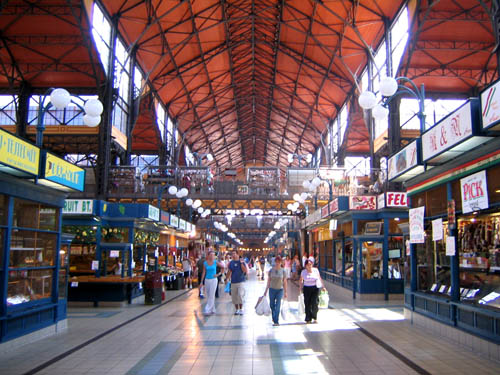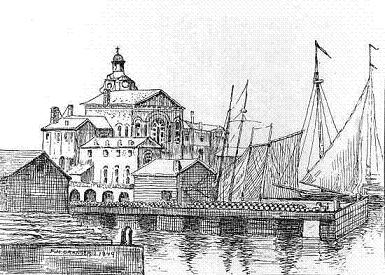I absolutely love living in the St. Lawrence Market neighborhood, and the number one reason why is the history.
There is no other neighborhood in the city that is as rich with Toronto’s history as the area surrounding Front Street.
I’d like to take a look at the St. Lawrence Market itself today and then for the rest of the week I’ll be profiling the other historical buildings in the area.
There it is in all it’s glory: the St. Lawrence Market.
Sure, Toronto’s best known landmark is obviously the CN Tower, but for those residents who aren’t that impressed with a tall, useless tower that was constructed for the sole purpose of giving Toronto a distinguishable identity, you might search a little bit further for historic landmarks such as Fort York or the St. Lawrence Market.
Check out this photo below:
What do you see here?
You see the Market, right? You see the shops below and the light pouring through the windows on the east side.
But wait a second….this isn’t the St. Lawrence Market!
This is actually the Great Market Hall in Budapest, Hungary!
Last December, I was lucky enough to travel in Serbia & Hungary and take in some of the sights and as much of the countries’ history as possible. The most astonishing place I found was the Great Market Hall, which seemed eerily similar to Toronto’s St. Lawrence Market!

I had been away for a little over four weeks, but walking through the Great Market Hall made me feel right at home as the parallels to the St. Lawrence Market were uncanny. Sure, the language was different and I bought two bottles of Absinthe, which you surely cannot purchase at the St. Lawrence Market, but it was amazing to see two city landmarks in two different countries that were almost identical.
The Great Market Hall in Budapest was built in 1897, almost a century after the original St. Lawrence Market was established in Toronto. Amazingly enough, there is one more parallel between the two landmarks that helped destroy and shape them at the same time: fire.
The Great Market Hall began construction in 1894, but in 1896 only a few days before it was scheduled to open, a fire destroyed half the roof and it took another year before it could be completed.
Perhaps they could have learned a few things from the early years of Toronto’s St. Lawrence Market…
The St. Lawrence Market dates back to 1803 before the name “St. Lawrence” was actually incorporated and it was simply known as the “Market Block.” Lieutenant Governor Peter Hunter proclaimed that all the land within the boundaries of Front Street, Jarvis, King, and Church would be officially designated as the market block, and farmers from nearby townships would bring their produce and livestock to the area to sell to residents of York Township (which later became Toronto).
Since 1803, the market itself has come in the form of many different buildings on many different locations. The first market itself was on the northern end of the Market Block fronting on to King Street (currently an RBC branch) and was a very small, 700 square foot wooden building. This is believed to have been built around 1820.
This building was used for about eleven years until it was replaced in 1831 by a larger more solid brick building which stretched all the way from King Street down to Front Street; this is currently where the north market is located which houses the current day “flea markets” on Sundays.
Then in 1849 came “the great fire.”
For those who have never heard of “the great fire,” consider it a turning point in Toronto’s history. The fire destroyed more than half of the City of Toronto, but in the aftermath came the construction of many of Toronto’s greatest landmarks.
One minor footnote here before we move on: the City of Toronto was incorporated from the Town of York in 1834, so the St. Lawrence Market actually pre-dates the City of Toronto itself. The intention behind the name change was to distinguish the city from “New York City” as well as a host of other counties and cities containing the term “York” in one fashion or another.
The reason for this footnote is the fact that when the City of Toronto was first incorporated, its city council members held meetings in small quarters inside the original Market Block! Over time, the site would also be home to a police station as well as the city jail.
But back to the great fire! The original Market Block was destroyed in 1849 and was rebuilt in 1851, only this time it would be named after Canada’s patron saint: St. Lawrence. Thus, the St. Lawrence Market was officially recognized.
Here is a sketch of the rear view of the market before the great fire in 1849. Notice that Front Street was actually on the lake at that time, hence the name “Front”:

In 1901, a need for a much larger market was recognized, and the south market was built on the site where most of us see the actual St. Lawrence Market today. Up until this time, the building considered the “market” was actually on the north side of Front street, although the whole block was considered the “market block.”
In 1904, the north market was completely demolished a new building was constructed in its place. A large canopy was erected over Front Street so that customers could walk from King Street through the north market to Front Street, and then to the south market all the while being covered from the elements.
In 1968, the north market was completely demolished again and replaced by the current building where the Sunday flea-market is held each week.
The south market, however, is a different story. Countless renovations took place from the building’s construction in 1901 right up to the 1970’s when the City of Toronto spent a decade debating what to do with the dilapidated building. In the end, they restored the building and kept the original structure intact while actually expanding the basement so that what used to be storage space could now be used by retailers to sell their goods.
Both the north and south markets have remained virtually unchanged since 1978.
This is by no means intended to be a complete history of the market, but rather a crude summary of the basic dates and events leading up to what we know as the St. Lawrence Market in 2009.
I love our city, and I love it’s history. Every time I walk down King Street or Front Street whether I’m late for an appointment or just out to buy a stick of butter, I marvel at how many original buildings are in our neighborhood and how immersed in history the St. Lawrence Market neighborhood actually is.
I contrast this to living in the evil CityPlace on the umpteenth floor, and I just can’t understand how people can look past all the history and tradition and long to live in a bland, desolate area with no identity.
I mentioned above how the great fire of 1849 destroyed half of the City of Toronto but paved the way for some more of Toronto’s landmark buildings. Tomorrow I’ll take a look at some of these landmarks, and other buildings in the St. Lawrence Market neighborhood that actually pre-date the fire itself!





























think.77
at 11:52 am
As a Torontonian, I appreciate this great history lesson about a special part of Toronto!
If only everybody had such a passion for the neighbourhoods that they work in!